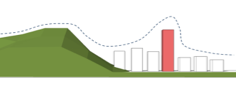Politique de gestion du paysage pour une meilleure Séoul
Background
Damaged Landscapes around Mountains, Rivers and Historic and Cultural Properties due to Reckless Development in the 1970-80's
Housing Supply-Centered Policy in Development & Growth Periods
Seoul underwent dramatic changes due to economic development in the 1960's, and started to focus on supplying houses in the 1970-80's. Based on the "Housing Construction Promotion Act" enacted in 1972, houses were supplied on a massive scale. Then, the "Housing Site Development Promotion Act" was also enacted to effectively promote large-scale housing site development in the 1980's. Then, a number of large apartment complexes were built across Seoul. In particular, the hill areas overcrowded by deteriorated houses were released from the restrictions on scenic areas, so that apartments could be built in those areas on a grand scale. The high-rise, high-density apartment development grew more fiercely due to the deregulation of building controls, such as an increase in both floor area ratio and building coverage ratio of apartments, and a lower pitch of buildings according to the housing construction promotion plan in 1985. However, the high-rise, high-density apartments around mountains and rivers began to destroy the urban landscape as a whole, producing an overwhelming and standardized view.
Downtown Redevelopment Policy for Modernization of Urban Functions
The "Urban Redevelopment Act" was enacted in 1976 and the "Basic Plan for Urban Redevelopment" was established for the first time in 1978. Then, the Seoul government complemented this basic plan and implemented active urban development by relaxing the restrictions on the floor area ratio and the building coverage ratio for residential complex development. This urban redevelopment policy brought about the modernization of urban functions, such as the construction of modern-style buildings, the improvement of road networks, and the expansion of parks and parking lots. However, it fell short of considering the historic and cultural characteristics of downtown areas, so many cultural heritages and urban structures across the city were destroyed by the large-scale urban development.
Natural Landscape Management with the Removal of "Namsan Oein Apartment" as Momentum
In 1991, the "Basic Plan for Namsan Mountain Recovery" made a proposal to transfer or remove ten encroaching facilities including the U.S. army facilities and the capital defense command (CDC), and transforming the enemy territory into a park. Then, Namsan Oein apartments were torn down in 1994 through the activities of the "Namsan Recovery Committee." The apartment concerned was built for the purpose of accommodating many foreigners who were invited to hand down advanced technology when the economic development plan was in active progress in the late 1960's. It stood high at the foot of Namsan Mountain, so it could be seen easily from everywhere, blocking the original scenic view of the mountain. At that time, its demolition was aired live on TV and served as an opportunity to raise public awareness about the value of landscape.
<Figure 1> Removal of Namsan Oein Apartments (1994)
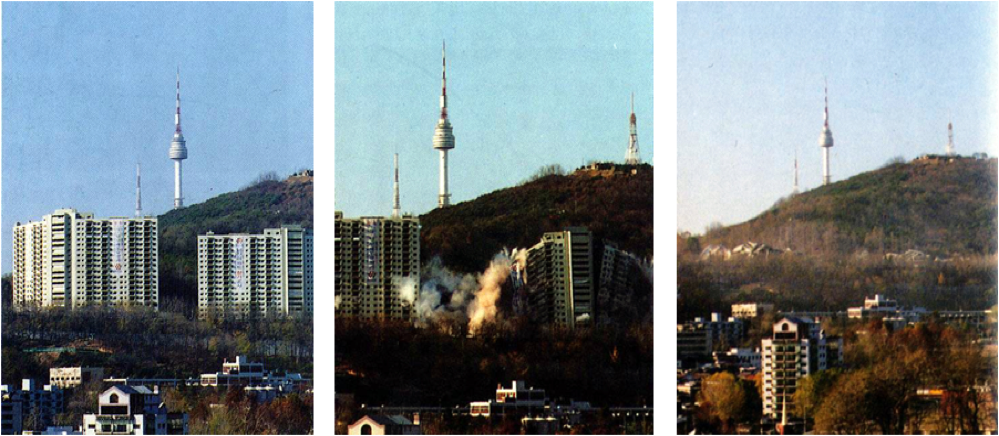
Scenic Conservation Act Implementation Focusing on Inducement and Support
In the early 1990's, the Seoul government and the academic circles started to recognize the necessity for managing the urban landscape, and came to establish many plans for controlling the height and scale of buildings. By doing so, they intended to secure the scenic view of mountains and rivers, which corresponded to landscape frameworks. However, the regulation-oriented landscape plan was non-statutory without an applicable law, so there was a limit to implementing the plans based on related laws. Also, the urban landscape is formed by means of urban plans, buildings, parks and green areas, etc., which are managed and operated according to individual laws (Land Planning and Utilization Act, Building Act and Act on Urban Parks, Greenbelts, etc.). Therefore, for the realization of landscape management, there was a growing need for implementation of an applicable law that covers all the landscape targets to be managed. Accordingly, the Scenic Conservation Act was enacted in 2007 to lay the institutional grounds for landscape resources preservation, management and formation, for example, establishing landscape plans, executing landscape projects, and concluding a landscape agreement with land owners and its support. Seoul City has established its statutory landscape plans for the first time as a local government based on the landscape ordinance in 2008 and the Scenic Conservation Act in 2009. Then, it mapped out specific landscape plans for each landscape type; natural green space, waterside, history and culture, nighttime and streets.
History
1st Period: Start of Protection and Management of Damaged Urban Landscapes
Seoul is a city with its own urban identity formed already by the landscape framework including its inner four mountains (Bugaksan, Naksan, Namsan and Inwangsan Mountains), outer four mountains (Bukhansan, Gwanaksan, Yongmasan/Achasan and Deokyangsan Mountains), the Hangang River and four streams (Hongjecheon, Jungrangcheon, Anyangcheon and Tancheon Streams), as well as downtown palaces, Hanyang Walls, traditional Korean-style houses and historic, cultural properties. Therefore, when there was a demand for managing damaged urban landscapes and protecting Seoul's own unique landscapes in the early 1990's, many efforts were made to secure scenic views of natural landscapes, centering on the related academic societies and research institutes. At the same time, related laws were enacted and amended to lay the institutional grounds for the realization of landscape management. Although the historic and cultural landscapes constituted a key element in forming the identity of Seoul along with its natural landscapes, the Seoul government was not very interested in protecting and managing the non-listed historic and cultural resources, while putting focus only on the listed historic and cultural properties.
Securing Scenic Views of Natural Landscape Resources like Mountains and Rivers
○ In many studies, it was suggested that a viewing point should be selected against theoretical backgrounds and the buildings between viewing points must be regulated, so that people could see the landscapes above the 5th to 7th ridges of mountains. For the realization of landscape management, they also suggested the designation of scenic districts, the application of deliberation standards, etc. However, in the case of designating scenic districts that may cause an infringement on property rights, we must first win the public consensus. When it comes to the height of buildings, which were defined by the existing use district system and setback regulation, there is a limit to regulating it with landscape plans without an applicable law. So, the methods for securing a view suggested in many studies have not been executed yet.
Protection and Formation of Historic and Cultural Landscapes through District Unit Planning
○ Historic and cultural landscape resources like ancient palaces and Hanyang Walls constitute a key element in forming the identity of Seoul, along with its natural landscapes like mountains and rivers. Nevertheless, almost no studies have been conducted so far with an aim of protecting and managing such landscapes. The listed historic and cultural properties have been protected by the cultural heritage protection area, elevation control, etc., but there was still a limit to forming the landscape of adjacent areas considering the corresponding cultural properties. Most of the non-listed historic and cultural landscape resources were also excluded from protection and management.
○ There was a growing demand for protecting and managing the historic, cultural resources and landscapes which had been lost and damaged during the rapid process of urban development. The Seoul government started to map out its district unit plans, centering on the characteristic bases of historic and cultural resources, such as Bukchon, Insa-dong and Myeong-dong. The district unit planning of characteristic bases was not intended for protecting and managing historic and cultural landscapes only, but has made contributions to their maintenance through detailed planning.
○ There was a growing demand for protecting and managing the historic, cultural resources and landscapes which had been lost and damaged during the rapid process of urban development. The Seoul government started to map out its district unit plans, centering on the characteristic bases of historic and cultural resources, such as Bukchon, Insa-dong and Myeong-dong. The district unit planning of characteristic bases was not intended for protecting and managing historic and cultural landscapes only, but has made contributions to their maintenance through detailed planning.
Laying the Institutional Grounds for Landscape Management
○ Seoul Architectural Committee Rules on Apartment House Design Review
- At a time when the reconstruction of large-scale apartments was progressing, the Seoul government had no means to conduct city management. Then, it managed to enact the "Seoul Architectural Committee Rules on Apartment House Design Review" in 1999 temporarily. These rules on apartment house design review were classified into indexical deliberation criteria and derivative deliberation criteria. The former includes an elevation area, elevation blockage ratio, height limit of hills, outdoor living space, sidewalk ratio and roadway ratio, while the latter includes a complex formation and layout plan, cutting/banking ratio, land deformation ratio, building type and number of stories, circulation planning in complex, structural plan, landscape plan, existing tree preservation, color plan and underground excavation. The rules on apartment house review were enacted according to the "Land Planning and Utilization Act" and manages the scale of apartment houses including a local floor area ratio, number of stories, maximum height, building layout and type. However, it was abolished in 2008 due to the enactment of the "Apartment House Architectural Design Review Standards" for securing the diversity of designs and forming high-quality residential environments.
○ Landscape Areas
- As the "Urban Planning Act" was completely revised in 2000, the Seoul government subdivided landscape areas into natural landscape, visual landscape, waterfront landscape, cultural heritage landscape, street landscape and prospect right landscape through the amendment of urban planning ordinances. On that basis, of the 24 scenic areas, which had been designated according to the Joseon Street Planning Act in 1941, 20 areas were changed into natural landscape areas and 4 areas were changed into visual landscape areas. Then, according to the "Land Planning and Utilization Act" enacted in 2003, which allowed the designation of natural landscape, waterfront landscape and street landscape areas, the Seoul government permitted the designation of visual landscape, cultural heritage landscape and prospect landscape areas through the revision of urban planning ordinances.
- However, it was difficult to designate new additional landscape areas, because people in the existing natural landscape areas continued to raise civil complaints against that type of designation because of its infringement on their property rights. Accordingly, the city council decided to delete some districts from designation, because they had not been designated before and had not produced actual benefits from separate regulations. Therefore, the prospect landscape areas and the cultural heritage landscape areas were deleted in 2009. Now, the Seoul government is allowed to designate the natural landscape, waterfront landscape and street landscape areas according to the Land Planning and Utilization Act and also designate visual landscape areas under the urban planning ordinance. As of 2013, the size of landscape areas totaled 13.1㎢, with only the natural and visual landscape areas designated.
○ Average Number of Stories
- Due to compulsory rental housing reconstruction in 2006, the floor area ratio was increased 10-30%, so it became inevitable to change the height limit of buildings in the type II general residential areas, of which floor area ratio and the number of stories were limited to 200% and 12-15, respectively. Furthermore, due to the previous limit on the maximum number of stories, the city landscape of housing areas looked too uniform and standardized. There were also continuous civil complaints regarding poor residential environments due to the difference in building heights from other nearby areas with lower height limits. Against these backdrops, for a variable sky line and better urban landscape, the Seoul government introduced the average number of stories (the number of stories obtained by dividing the ground area of apartments by a reference area, under Clause 2, Article 28 of the Seoul Urban Planning Ordinance) for the first time as a local government through the revision of the Seoul Urban Planning Ordinance.
- In the case of building apartments in the District Unit Planning Areas and Renewal Areas, the average number of stories was alleviated and changed to 11 for type II general residential areas (7 stories or less), and 16 for type II general residential areas (12 stories or less), considering their contribution to public interests through a land donation for public sites as well as their potential improvement to the landscapes of adjacent areas.
- Then, in 2009, there was an attempt to compensate the issues of hills, which formed a uniform and standardized landscape view due to the application of the absolute number of stories without considering geographical characteristics. Therefore, the type II general residential areas were divided into hill and flatland areas and the differential criteria for alleviating the limit on the number of stories were applied there, considering regional characteristics, while maintaining the framework of the subdivision (7 and 12 stories) of type II general residential areas. On the contrary, the districts in need of landscape management were excluded from the alleviation of the limit on number of floors. By doing so, the government set a strict restriction on the simple upgrade of building stories in use districts. However, if an architectural plan (special landscape design, etc.) for hills has been made through a design competition or if there has been a consultation with the committee in advance, the government could apply separate criterion to that case within a scope of 18 stories on average, thus enabling architectural planning of various designs in practice. Meanwhile, in the case of building apartments in a structure capable of easy remodeling, the average number of stories could be relaxed within 20% of the corresponding standards. By doing so, the government took measures to prevent reckless reconstruction from causing any environmental damage and waste of resources.
- At a time when the reconstruction of large-scale apartments was progressing, the Seoul government had no means to conduct city management. Then, it managed to enact the "Seoul Architectural Committee Rules on Apartment House Design Review" in 1999 temporarily. These rules on apartment house design review were classified into indexical deliberation criteria and derivative deliberation criteria. The former includes an elevation area, elevation blockage ratio, height limit of hills, outdoor living space, sidewalk ratio and roadway ratio, while the latter includes a complex formation and layout plan, cutting/banking ratio, land deformation ratio, building type and number of stories, circulation planning in complex, structural plan, landscape plan, existing tree preservation, color plan and underground excavation. The rules on apartment house review were enacted according to the "Land Planning and Utilization Act" and manages the scale of apartment houses including a local floor area ratio, number of stories, maximum height, building layout and type. However, it was abolished in 2008 due to the enactment of the "Apartment House Architectural Design Review Standards" for securing the diversity of designs and forming high-quality residential environments.
○ Landscape Areas
- As the "Urban Planning Act" was completely revised in 2000, the Seoul government subdivided landscape areas into natural landscape, visual landscape, waterfront landscape, cultural heritage landscape, street landscape and prospect right landscape through the amendment of urban planning ordinances. On that basis, of the 24 scenic areas, which had been designated according to the Joseon Street Planning Act in 1941, 20 areas were changed into natural landscape areas and 4 areas were changed into visual landscape areas. Then, according to the "Land Planning and Utilization Act" enacted in 2003, which allowed the designation of natural landscape, waterfront landscape and street landscape areas, the Seoul government permitted the designation of visual landscape, cultural heritage landscape and prospect landscape areas through the revision of urban planning ordinances.
- However, it was difficult to designate new additional landscape areas, because people in the existing natural landscape areas continued to raise civil complaints against that type of designation because of its infringement on their property rights. Accordingly, the city council decided to delete some districts from designation, because they had not been designated before and had not produced actual benefits from separate regulations. Therefore, the prospect landscape areas and the cultural heritage landscape areas were deleted in 2009. Now, the Seoul government is allowed to designate the natural landscape, waterfront landscape and street landscape areas according to the Land Planning and Utilization Act and also designate visual landscape areas under the urban planning ordinance. As of 2013, the size of landscape areas totaled 13.1㎢, with only the natural and visual landscape areas designated.
○ Average Number of Stories
- Due to compulsory rental housing reconstruction in 2006, the floor area ratio was increased 10-30%, so it became inevitable to change the height limit of buildings in the type II general residential areas, of which floor area ratio and the number of stories were limited to 200% and 12-15, respectively. Furthermore, due to the previous limit on the maximum number of stories, the city landscape of housing areas looked too uniform and standardized. There were also continuous civil complaints regarding poor residential environments due to the difference in building heights from other nearby areas with lower height limits. Against these backdrops, for a variable sky line and better urban landscape, the Seoul government introduced the average number of stories (the number of stories obtained by dividing the ground area of apartments by a reference area, under Clause 2, Article 28 of the Seoul Urban Planning Ordinance) for the first time as a local government through the revision of the Seoul Urban Planning Ordinance.
- In the case of building apartments in the District Unit Planning Areas and Renewal Areas, the average number of stories was alleviated and changed to 11 for type II general residential areas (7 stories or less), and 16 for type II general residential areas (12 stories or less), considering their contribution to public interests through a land donation for public sites as well as their potential improvement to the landscapes of adjacent areas.
- Then, in 2009, there was an attempt to compensate the issues of hills, which formed a uniform and standardized landscape view due to the application of the absolute number of stories without considering geographical characteristics. Therefore, the type II general residential areas were divided into hill and flatland areas and the differential criteria for alleviating the limit on the number of stories were applied there, considering regional characteristics, while maintaining the framework of the subdivision (7 and 12 stories) of type II general residential areas. On the contrary, the districts in need of landscape management were excluded from the alleviation of the limit on number of floors. By doing so, the government set a strict restriction on the simple upgrade of building stories in use districts. However, if an architectural plan (special landscape design, etc.) for hills has been made through a design competition or if there has been a consultation with the committee in advance, the government could apply separate criterion to that case within a scope of 18 stories on average, thus enabling architectural planning of various designs in practice. Meanwhile, in the case of building apartments in a structure capable of easy remodeling, the average number of stories could be relaxed within 20% of the corresponding standards. By doing so, the government took measures to prevent reckless reconstruction from causing any environmental damage and waste of resources.
<Table 3> Improvement Proposal for Average Number of Stories (2009)
| Use Districts | Classification | Reference Number of Stories | Maximum Number of Stories | Infrastructure Burden Ratio |
| Type II General Residential Area (7 stories or less) |
Hill | 10 stories or less on average | 13 stories or less on average | 5% |
| Flatland | 13 stories or less on average | 10% | ||
| Type II General Residential Area (12 stories or less) |
Hill | 15 stories or less on average | 18 stories or less on average | 5% |
| Flatland | 18 stories or less on average | 10% |
- By considering the ordinance on the limited number of building stories in type II general residential areas through the revision of the Land Planning and Utilization Act in 2012, the Seoul government maintained the limit on the number of stories in type II general residential areas (7 stories or less), but abolished that limit on type II general residential areas (12 stories or less). In the case of building apartments, the government tried to suppress reckless high-density developments by setting a limit to the number of stories through the committee's deliberation for the purpose of managing the landscapes and protecting residential environments. Therefore, in the case of building apartments in type II general residential areas, the number of stories must be limited to 7 on average. However, such number could be relaxed to 13 or less on average, as long as some of the land is donated for public facilities.
2nd Period: Landscape Planning based on Induction/Support-Centered Scenic Conservation Act
The Seoul government established its basic landscape plan in 2009 based on the Scenic Conservation Act implemented in 2007, and mapped out a specific landscape plan for each landscape type in the following year. The Seoul Basic Landscape Plan was designed to lay the framework for landscape planning and served as an opportunity to systematically integrate and organize basic concepts and management methods for each landscape type (natural green areas, waterfront, historic & cultural landscapes, etc.), which had been accumulated during a non-statutory landscape planning process.
Local Government's First Statutory Landscape Plan based on the Scenic Conservation Act
○ The Seoul Basic Landscape Plan was mapped out according to the guidelines on landscape planning notified by the former Ministry of Construction and Transportation (currently the Ministry of Land, Infrastructure and Transport) in 2008. Accordingly, the framework for landscape plans was prepared for the first time on institutional grounds. The basic landscape plan clearly presented the areas that need landscape management, and also suggested the guidelines for landscape design for buildings to be built within landscape management areas.
<Figure 2> Landscape Basic Management Area and Landscape Intensive Management Area

- The citizens and public parties could share the necessity for landscape management in the areas concerned by preparing the criteria for setting the scope of landscape management and raising civil awareness about the necessity for landscape management. Also, the boundary of landscape management areas was drawn with GIS data, so that it could be easily be used for mapping out a related plan and promoting a project.
- The landscape design guidelines contain the minimum principles required for protecting and preserving the valuable landscape resources within the management areas, and are designed to share the value of surrounding landscape resources, facilitate the construction of buildings considering landscapes and create a coherent view of buildings within the same management area.
• Designers should check whether buildings belong to the landscape management areas or not, figure out the type of landscape design guidelines, and conceive the concepts of buildings by considering those guidelines. Before the approval and review of buildings, designers should write the answers ("fully consider," "consider," etc.) to questions regarding their considerations of the landscape design guidelines for eight items (layout, scale/height, shape/appearance, material, outdoor space, nighttime view, color and outdoor advertisement) and submit them with accompanying documents upon approval and review.
- The landscape design guidelines contain the minimum principles required for protecting and preserving the valuable landscape resources within the management areas, and are designed to share the value of surrounding landscape resources, facilitate the construction of buildings considering landscapes and create a coherent view of buildings within the same management area.
• Designers should check whether buildings belong to the landscape management areas or not, figure out the type of landscape design guidelines, and conceive the concepts of buildings by considering those guidelines. Before the approval and review of buildings, designers should write the answers ("fully consider," "consider," etc.) to questions regarding their considerations of the landscape design guidelines for eight items (layout, scale/height, shape/appearance, material, outdoor space, nighttime view, color and outdoor advertisement) and submit them with accompanying documents upon approval and review.
<Table 3> Scale/Height Checklist for Landscape Basic Design Guidelines on Inner/Outer Mountains
| Key Word | Landscape Checklist | Evaluation | |||||
| Harmony with Surroundings | To promote scale and height that harmonizes with inner/outer mountains and surrounding features |
|
|||||
| Skyline | To form a skyline that considers natural geographical features To map out a height plan to secure the view up to the 5th ridge of the summit of mountains |
|
|||||
| No Feeling of Oppression | To avoid excessively large and protruding buildings - Not to block a scenic view or cause a feeling of oppression by folding screen-type buildings or a group of buildings - Divide buildings and design in a slender type in harmony with surrounding landscapes |
|
|||||
| Memo | |||||||
| ※ This box is for designers to write their opinions. You can self-check each item as or use for your explanation about plans. (Related drawing, simple sketch, sentence, etc.) |
|||||||
| Evaluation: Fully considered → ◎ Considered → ○ Not considered → × | |||||||
| Source: Seoul Map Homepage (http://gis.seoul.go.kr) | |||||||
Writing Checklist for Landscape Design Guidelines, Institutionalizing its Submission and Executing the Landscape Self-Check System
○ For the approval and review of buildings, it was suggested that a checklist for landscape design guidelines should be written and submitted in advance. Its pilot operation was conducted from April 2009 to March 2011. After the end of the pilot operation, its results were monitored from March to August, 2011 before the system was put into compulsory execution. As a result, it was necessary to complement the defects of the new system and extend the period of the pilot operation. So, the period was extended to December, 2011 and the system was complemented more. As of January, 2012, the system was renamed into the landscape self-check system and is now put into compulsory execution.
- The Seoul Development Institute (currently the Seoul Institute) monitored a landscape self-check system from March to August, 2011 through the "Evaluation on landscape management operation according to the Seoul landscape plan and the study on improvement plans." As a result of the monitoring, the rate of checklists submitted tended to increase gradually, but still low, within 20%. It also appeared that the errors on the checklists were not addressed yet. However, about 50% of qualified architects replied that the landscape design guidelines made contributions to the improvement of landscapes. In particular, it raised public awareness about the landscape itself and helped to present a direction of plans considering the landscape.
- Furthermore, it appears that public officials recognized just 50% of the targets subject to checklists submission, and there was a very large deviation in the operational results for each autonomous district (Gu). It suggests that the operational results might vary a lot depending on public officials' attentions and efforts.
- The Seoul Development Institute (currently the Seoul Institute) monitored a landscape self-check system from March to August, 2011 through the "Evaluation on landscape management operation according to the Seoul landscape plan and the study on improvement plans." As a result of the monitoring, the rate of checklists submitted tended to increase gradually, but still low, within 20%. It also appeared that the errors on the checklists were not addressed yet. However, about 50% of qualified architects replied that the landscape design guidelines made contributions to the improvement of landscapes. In particular, it raised public awareness about the landscape itself and helped to present a direction of plans considering the landscape.
- Furthermore, it appears that public officials recognized just 50% of the targets subject to checklists submission, and there was a very large deviation in the operational results for each autonomous district (Gu). It suggests that the operational results might vary a lot depending on public officials' attentions and efforts.
Agreement on Landscapes and Promotion of Landscape Projects
○ The landscape project is designed to improve regional landscapes and raise public awareness about landscapes. A landscape agreement project leads residents to participate in preserving, managing and forming landscapes for more pleasant environments and more desirable landscapes.- For some preferential landscape projects, the basic landscape plan presented a Seoul Fortress Wall gateway formation project, a station area landscape improvement project, a ground steel structure upgrade, a specialized street formation project and a gateway landscape formation project. Out of them, the gateway landscape formation project was conducted as a pilot project. The landscape agreement project was performed to target three places (Ui-dong of Gangbuk-gu, Sinwol 2-dong of Yangcheon-gu and Junggok-dong of Gwangjin-gu) after accepting applications from autonomous districts (Gu). However, in the case of Junggok-dong, its agreement was cancelled according to the residents' opinions.
<Figure 3> Gateway Landscape Formation Project (before/after the project)

Specific Landscape Planning by Landscape Types
○ The basic landscape plan is a landscape master plan that builds a big framework and processes for preserving, managing and forming Seoul City landscapes, while the specific landscape plan presents the execution methods for preserving, managing and forming landscapes with specific landscape types (forest, waterfront, agricultural/fishing village, history/culture, street, etc.) on the basis of specific environmental elements (nighttime landscape, color, outdoor advertisement, public facilities, etc.) and is based on the landscape plan guidelines.
○ The Seoul government established a specific landscape plan for four landscape types (natural green area, waterfront, history/culture and street) along with basic landscape plans. Out of them, the street landscape plan was established first in 2009, targeting the streets that urgently needed landscape management and were highly likely to show the effects of improvement. Then, it established a landscape plan for natural green areas, waterfronts and history/culture in 2010. Additionally, it mapped out a nighttime landscape plan as a specific landscape plan for each specific element in 2009.
○ The Seoul government established a specific landscape plan for four landscape types (natural green area, waterfront, history/culture and street) along with basic landscape plans. Out of them, the street landscape plan was established first in 2009, targeting the streets that urgently needed landscape management and were highly likely to show the effects of improvement. Then, it established a landscape plan for natural green areas, waterfronts and history/culture in 2010. Additionally, it mapped out a nighttime landscape plan as a specific landscape plan for each specific element in 2009.
<Figure 4> Seoul Landscape Plan System


○ The specific landscape plan set the strategy and management elements based on its basic concept for each landscape type, which was established in the basic landscape plan, and also prepared criteria for landscape formation.
- The criteria for landscape formation are either planning principles or criteria for establishing a planning direction, so that the related plans (district unit plan, renewal promotion plan, basic plan for urban and residential environment renewal, etc.) and the related projects (landscape project, street environment improvement project, urban planning facilities project, etc.) can be promoted according to a landscape strategy.
- The criteria for landscape formation are either planning principles or criteria for establishing a planning direction, so that the related plans (district unit plan, renewal promotion plan, basic plan for urban and residential environment renewal, etc.) and the related projects (landscape project, street environment improvement project, urban planning facilities project, etc.) can be promoted according to a landscape strategy.
<Figure 5> Strategy for Seoul Natural Green, Waterfront and Historic/Cultural Landscape Plans and Criteria for Landscape Formation
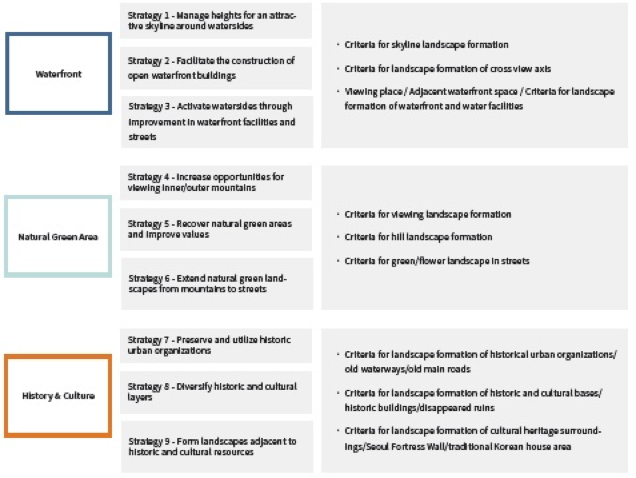

○ The plan for natural green landscapes established management elements such as prospect, hills, streets and green areas/flowers and prepared the criteria for landscape formation based on its strategy for increasing viewing opportunities of inner and outer mountains, recovering natural green areas, improving values, and extending the natural green landscapes from mountains to streets.
- The government determined 251 viewing points and 35 viewing axes according to the plan and set Samil-ro, Hangang-ro, Seun Green Axis, etc. as a view landscape formation area, which overlapped with the no. 1 view point and axis according to the priority of view landscape formation and management.
- The government determined 251 viewing points and 35 viewing axes according to the plan and set Samil-ro, Hangang-ro, Seun Green Axis, etc. as a view landscape formation area, which overlapped with the no. 1 view point and axis according to the priority of view landscape formation and management.
<Figure 6> Samil-ro View Landscape Formation Area (Seoul Natural Green Landscape Plan, 2010, p71)
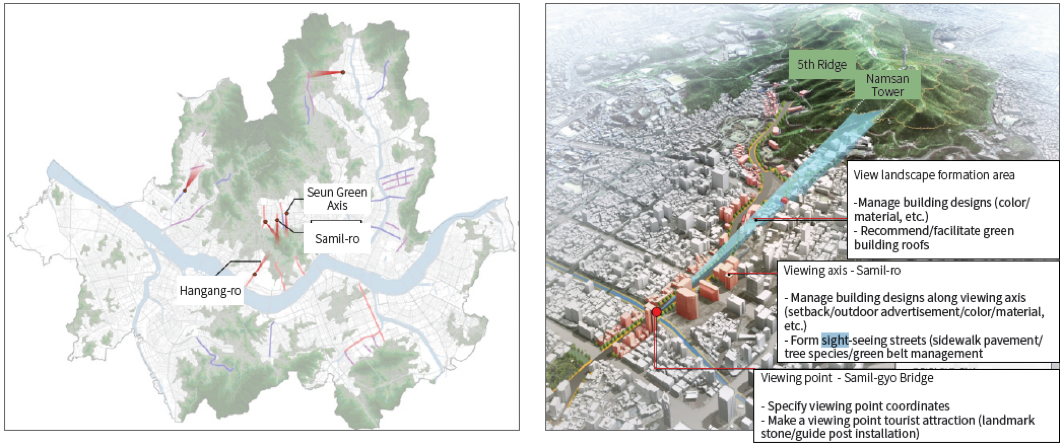
○ The waterfront landscape plan set its management elements such as a skyline, a cross view axis, a viewing place, adjacent waterfront space, and waterfront and waterborne facilities and prepared landscape formation criteria, based on its strategy for height management to produce an attractive skyline around the waterside, facilitate the construction of open waterfront buildings and improving waterfront facilities and streets.
- In particular, the various plans such as the Hangang Renaissance Master Plan (2007), the Hangang Public Reform Plan (2009) and the Hangang Stream Local Development Plan Study (2009), created new waterfront landscapes and presented various issues about the skyline. The waterfront landscape plan reflected a framework for height management of related plans and designated the stream sides without a prior height plan (Jungnangcheon Stream, Bulgwangcheon Stream of Hongje, Dorimcheon Stream of Anyang, Tancheon Stream of Yangje, etc.) as height management areas.
- In particular, the various plans such as the Hangang Renaissance Master Plan (2007), the Hangang Public Reform Plan (2009) and the Hangang Stream Local Development Plan Study (2009), created new waterfront landscapes and presented various issues about the skyline. The waterfront landscape plan reflected a framework for height management of related plans and designated the stream sides without a prior height plan (Jungnangcheon Stream, Bulgwangcheon Stream of Hongje, Dorimcheon Stream of Anyang, Tancheon Stream of Yangje, etc.) as height management areas.
<Table 4> Classification of Height Management of Waterfront Landscape Plans
| Area | Management Direction | Target Areas |
| Height preservation area | Form a landscape that adapts itself to and harmonizes with natural topography | Mapo/Seogang, Hannam/Oksu, Heukseok/Noryangjin |
| Height management area | Form a landscape in harmony with surrounding areas | Landscape management areas excluding height-preserving/inducing/alleviating areas |
| Height induction area | Form a waterfront landscape full of vitality through the introduction of multi-purpose designs | Hapjeong, Dangsan, Ichon, Banpo, Seongsu and Guui/Jayang |
| Height alleviation area | Create a new landmark landscape around the waterfront area | Yongsan, Yeouido, Apgujeong and Jamsil |
<Figure 7> Height Management-Applied Areas (Seoul Waterfront Landscape Plan, 2010, p55)
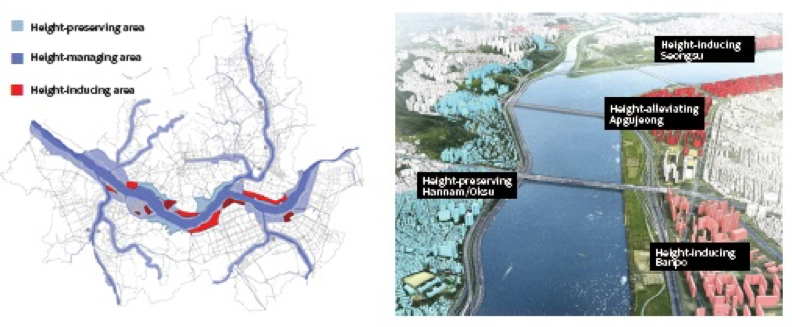

- The historic and cultural landscape plan set its management elements such as a historic urban organization, old waterways, old roads, historic and cultural bases, historic landscape buildings, disappeared ruins, cultural heritage areas, Seoul Fortress Wall and traditional Korean house areas and prepared landscape formation criteria, based on its strategy for preserving and utilizing historic urban organizations, diversifying historical and cultural layers and forming landscapes around historic and cultural resources. Through this first plan for historic and cultural landscapes, it suggested the necessity for managing the non-listed historic and cultural heritage as well as old landscape resources like old waterways, disappeared ruins and old roads.
<Table 5> Classification of Historic Urban Organization Areas
| Area | Management Direction | Target Areas |
| Historic Features-preserving district | Maintaining and preserving the original form of old urban organizations | Bukchon, Seochon, Insa-dong and Donhwamun-ro |
| Historic features-managing district | Maintaining and managing the characteristics of old urban organizations | Sejong-ro, Jeong-dong, Bukchang-dong, Myeong-dong, Gwancheol-dong and Gwangjang-dong |
| Small-unit maintenance district | Protecting the characteristics of old urban organizations | Gongpyeong-dong, Gwansu-dong, Chungmu-ro, Jongno 5, 6 ga-dong, Gwanghui-dong, etc. |
| Large-unit maintenance district | Considering and utilizing old urban organizations | Large-scale development plan areas (urban environment maintenance area, renewal promotion area, special planning area, etc.) |
<Figure 8> Historical Urban Organization Areas and Examples (Seoul Historic and Cultural Landscape Plan, 2010, p62)
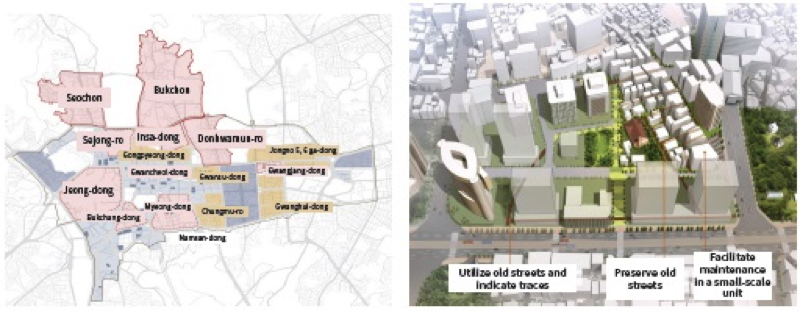

Landscape Project Proposal by Types
○ The specific landscape plan presents strategic landscape projects that public sectors must promote according to the strategy for each landscape type. The landscape project must be promoted in connection with landscape agreements so that residents can participate in landscape management.
<Figure 9> Seoul Natural Green/Waterfront/Historic & Cultural Landscape Plan and Landscape Project Examples
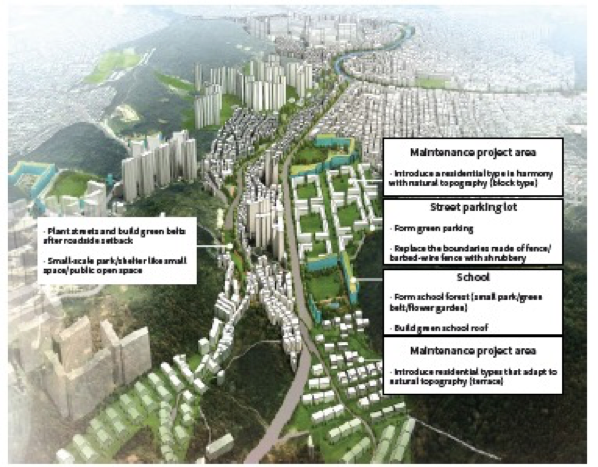
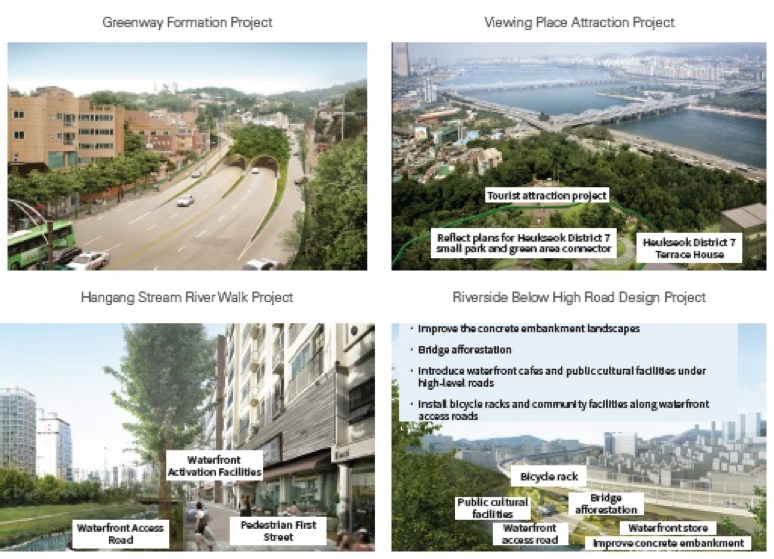
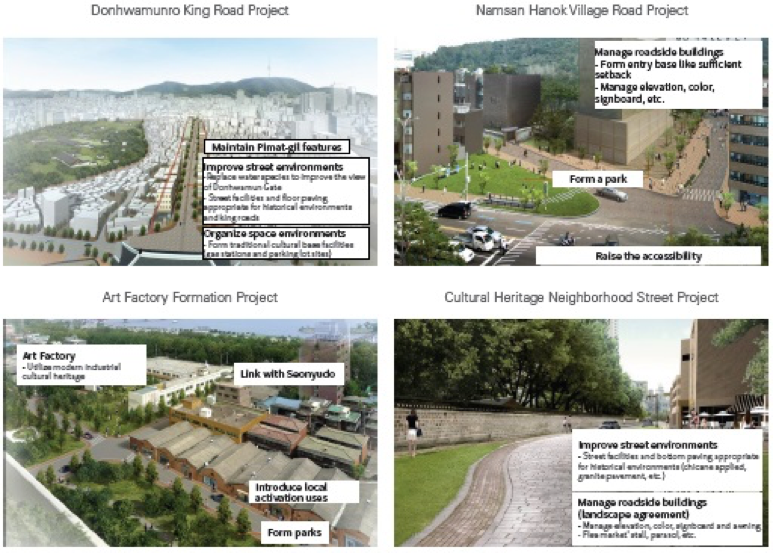
The 3rd Period | Landscape Plan Renewal according to Changed Conditions
Based on the Scenic Conservation Act, the Seoul government constructed a framework for landscape plans and prepared its management methods for each landscape type. However, the existing scenic conservation act did not have the full power of execution for landscape plans due to the absence of its management means and its overly wide scope of target business caused redundancy and confusion. Accordingly, the Ministry of Land, Infrastructure and Transport revised the Scenic Conservation Act as a whole in 2014 and the Seoul government launched the renewal of landscape plans according to changed situations. It established the plans for managing Hangang skylines and the historical center in the four main gates at the same time. So, it is necessary to review and reflect the related contents upon the renewal of landscape plans.
Laying the National Groundwork for Systematic and Integrated Landscape Management
○ Due to the revision of the Scenic Conservation Act, the roles of the central government were newly established in terms of landscape policies. The Ministry of Land, Infrastructure and Transport established and executed the basic plans for landscape policies every five years, made it compulsory to establish and execute the landscape plans for do/si/gun that exceeds a population of 100,000 people, and laid the framework for the local government to secure its power of execution in landscape management.
<Figure 10> Main Contents of Revised Scenic Conservation Act
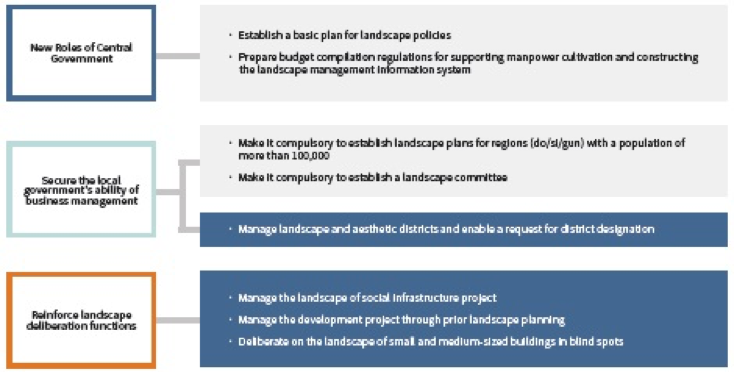

※ The parts shaded are the contents of Seoul landscape policy.
- Out of the revised Scenic Landscape Act, the matters that need to be considered during the renewal of Seoul landscape plans are the matters regarding the landscape and aesthetic districts.
• In the previous scenic conservation act, landscape deliberation was limited only to landscape plans, project approval and landscape agreement's permission. In the revised scenic conservation act, the deliberation targets are extended to social infrastructures, development projects, buildings, etc., so it is necessary to map out plans for rational landscape deliberation.
• It becomes possible to manage and designate the landscape and aesthetic districts using landscape plans. It is required to set management directions for maintaining, changing and abolishing districts through the survey of actual conditions of the current landscape and aesthetic districts.
- Out of the revised Scenic Landscape Act, the matters that need to be considered during the renewal of Seoul landscape plans are the matters regarding the landscape and aesthetic districts.
• In the previous scenic conservation act, landscape deliberation was limited only to landscape plans, project approval and landscape agreement's permission. In the revised scenic conservation act, the deliberation targets are extended to social infrastructures, development projects, buildings, etc., so it is necessary to map out plans for rational landscape deliberation.
• It becomes possible to manage and designate the landscape and aesthetic districts using landscape plans. It is required to set management directions for maintaining, changing and abolishing districts through the survey of actual conditions of the current landscape and aesthetic districts.
Hangang Riverside Skyline Management
○ The Seoul government has carried out various policies from the 1980's recognizing the importance of Hangang River. In particular, it has promoted the policy for recovering Hangang River's public spirits in 2009, targeting the large-scale reconstruction and redevelopment project sites around the Hangang Riverside. However, it was impossible to execute the project due to the residents' objections against integrated development and land donation. It also caused social disputes over an excessive height (50 stories or so), excessive floor area ratio (330% level), the appropriateness of land donation, etc.
○ Additionally, Hangang Renaissance Master Plan, which served as a policy attempt regarding Hangang River as a whole, did not lead to a long-term plan. It only revealed a limit to the comprehensive urban management in a view point of urban landscape, so there was a growing demand for systematic and long-term plans for Hangang Riverside. Therefore, the Seoul government announced directions for Hangang Riverside management that consisted of four principles and seven detailed management principles for managing Hangang River, and planned to materialize the "Hangang Riverside Management Master Plan" by the first half of 2015 based on the management direction.
- With regard to the skyline, it has set the principles of "management for urban space structure and hierarchy," "management in harmony with Seoul's unique natural scenic resources," and "management for protecting historic and cultural heritages," and has prepared height standards according to space structures.
○ Additionally, Hangang Renaissance Master Plan, which served as a policy attempt regarding Hangang River as a whole, did not lead to a long-term plan. It only revealed a limit to the comprehensive urban management in a view point of urban landscape, so there was a growing demand for systematic and long-term plans for Hangang Riverside. Therefore, the Seoul government announced directions for Hangang Riverside management that consisted of four principles and seven detailed management principles for managing Hangang River, and planned to materialize the "Hangang Riverside Management Master Plan" by the first half of 2015 based on the management direction.
- With regard to the skyline, it has set the principles of "management for urban space structure and hierarchy," "management in harmony with Seoul's unique natural scenic resources," and "management for protecting historic and cultural heritages," and has prepared height standards according to space structures.
<Table 6> Heights by Hangang Riverside Skyline Management Principles
| Use District | Downtown/Subcenter | Region/district-centered | Other Areas |
| Commercial/Semi-Residential | Multipurpose: 51 stories or more, Residential: 35 stories or less | Multipurpose: 50 stories or less, Residential: 35 stories or less | Multi-purpose: 40 stories or less Residential: 35 stories or less |
| Semi-Industrial | Multipurpose: 50 stories or less, Residential: 35 stories or less | ||
| General Residential | General type III: 35 stories or less (residential), Residential: 35 stories or less, Multipurpose: 50 stories or less General type II: 25 stories or less |
General type III: 35 stories or less General type II: 25 stories or less |
|
Management of Historical Center within Four Gates Considering the Changed Downtown Conditions
○ After the basic plan for Seoul downtown management (2000), the "downtown development plan according to Cheonggyecheon restoration" established in 2004 was a non-statutory plan, but has run so far as a plan with an administrative binding force. However, due to the changes in downtown conditions and the increase in awareness about history and culture, there has been a demand for new plans for reforming the existing plans since 2004.
○ The Seoul government established "Basic plan for historic and cultural city management" in 2012 as a basic plan for managing the city within four gates as a historic and cultural city, and mapped out the "basic plan for downtown management considering history and culture" in 2014.
- The basic plan for historic and cultural city management presented basic principles and directions for managing historic and cultural resources, and preserving and utilizing historical space and scope. On the other hand, the basic plan for downtown management presented the policy direction and guidelines for land use, space structure, development density, walking and transportation, dwelling, parks & green areas, landscape and height limit.
○ The Seoul government established "Basic plan for historic and cultural city management" in 2012 as a basic plan for managing the city within four gates as a historic and cultural city, and mapped out the "basic plan for downtown management considering history and culture" in 2014.
- The basic plan for historic and cultural city management presented basic principles and directions for managing historic and cultural resources, and preserving and utilizing historical space and scope. On the other hand, the basic plan for downtown management presented the policy direction and guidelines for land use, space structure, development density, walking and transportation, dwelling, parks & green areas, landscape and height limit.
Progress
<Table 7> Promotional Details of Landscape Management Policy
| Year | Established laws, systems and plans | Content |
|---|---|---|
| 1941 | Plan for Joseon streets |
|
| 1994 | Removed Namsan Oein Apartments |
|
| 1999 | Seoul Architectural Committee Rules on Apartment House Construction Review |
|
| 2000 | Enacted the Urban Planning Act |
|
| Revised the ordinance on Seoul urban plans |
|
|
| 2003 | Enacted the Land Planning and Utilization Act |
|
| Revised the ordinance on urban planning in Seoul |
|
|
| 2005 | 2020 Seoul Urban Basic Plan |
|
| 2006 | Introduced the average number of stories |
|
| Revised Seoul's urban design ordinance |
|
|
| Established basic plans for Seoul urban design |
|
|
| 2007 | Enacted the Scenic Conservation Act |
|
| Enacted the Framework Act on Building |
|
|
| 2008 | Enacted the Seoul ordinance on landscapes |
|
| Established and systematized Seoul colors |
|
|
| 2009 | Established Seoul basic landscape plan |
|
| Improvement plan for average number of stories |
|
|
| 2010 | Established specific landscape plans in Seoul |
|
| 2011 | Monitored the landscape self-check system |
|
| Established Seoul basic construction plans |
|
|
| Reformed Seoul urban design basic plan |
|
|
| 2012 | Executed the compulsory landscape self-check system |
|
| 2013 | Improvement plan for average number of stories |
|
| Hangang Riverside management direction |
|
|
| 2014 | 2030 Seoul urban basic plan |
|
| Revised the Scenic Conservation Act as a whole |
|
|
| Enacted Seoul landscape ordinance | • Enacted as a whole and executed (May 2014) | |
| Seoul landscape plan under renewal | • Academic research on Seoul landscape plan renewal, Seoul Institute (May 2014 - Feb. 2015) |
Results
Contribution to Establishing Seoul Identity
With a growing demand for protecting and managing the urban landscape, Seoul's landscape management policy started from the late 1990's and has been launched in earnest beginning in 2000. The Seoul government has made multilateral efforts by setting clear regulations on natural landscapes and historic/cultural landscapes that need protection and management, and operating flexible guidelines on street landscapes that need the creation of a new landscape, centering on inducement and support. For about 20 years, the Seoul government's landscape policies have made contributions to establishing Seoul's identity by keeping harmony with natural landscapes such as inner/outer mountains, Hangang River and main streams, and preserving and utilizing the historical and cultural resources spanning 600 years of history.
Presenting a direction for landscape plans
The landscape basic plan, which presented the urban future and goals for each landscape type, such as natural green, waterfront and historic/cultural landscapes, maintained the plan and basis for urban basic plan by landscape areas, and also presented a basic direction and principle for Seoul landscapes in urban influential areas such as urban planning, construction, design and park/green area. The non-statutory plan without administrative binding force laid the grounds for urban landscape management by establishing the basic landscape plan, and the Seoul government could promote consistent landscape management by establishing a consistent plan.
Improving urban landscapes and raising public awareness with the promotion of landscape agreement and project
The public-led landscape project serves as a means to realizing the basic concept and strategy of landscape plans. The promotion of the pilot project, which was proposed through the basic landscape plan, has made contributions to creating a visual landscape of Seoul. Furthermore, based on the post evaluation after the project, the landscape agreement project suggested that we would need a method for encouraging civic participation and a strategy for improving civil satisfaction. However, it was promoted based on civic participation, thus helping residents themselves feel the necessity for landscape management. By doing so, it has made great contributions to raising public awareness about urban landscapes.
References
Mok Jeong-hun, 2005, “Study on How to Manage Apartment House Heights in Residential Areas: Centering on Type II General Residential Areas”, Seoul Institute
Park Hyeon-chan, 2014, “Strategy for Landscape Policy Improvement according to Revised Scenic Conservation Act”, Seoul Institute's Policy Report 175
Park Hyeon-chan, Min Seung-hyeon, 2014, “Study on Landscape Policy Improvement Directions in Seoul according to Revised Scenic Conservation Act," Seoul Institute
Seoul Metropolitan City, 1991, Namsan Recovery Master Plan
Seoul Metropolitan City, 2000, Seoul Plan for Mountain Scenic Landscape Conservation
Seoul Metropolitan City, 2002, Seoul Plan for Mountain Viewing Landscape Conservation
Seoul Metropolitan City, 2005, Seoul Basic Plan for Landscape Management
Seoul Metropolitan City, 2009, Seoul Basic Landscape Plan
Seoul Metropolitan City, 2010, Seoul Plan for Street Landscapes
Seoul Metropolitan City, 2010, Seoul Plan for Natural Green Landscapes
Seoul Metropolitan City, 2010, Seoul Waterfront Landscape Plan
Seoul Metropolitan City, 2010, Seoul Plan for Historic and Cultural Landscapes
Seoul Metropolitan City, 2012, Basic Plan for Historic and Cultural City Management in Four Gates of Seoul
Lee Seong-chang, Park Hyeon-chan, 2011, “Study on Landscape Management Evaluation and Improvement Plans according to Seoul Landscape Plan,” Seoul Institute
Park Hyeon-chan, 2014, “Strategy for Landscape Policy Improvement according to Revised Scenic Conservation Act”, Seoul Institute's Policy Report 175
Park Hyeon-chan, Min Seung-hyeon, 2014, “Study on Landscape Policy Improvement Directions in Seoul according to Revised Scenic Conservation Act," Seoul Institute
Seoul Metropolitan City, 1991, Namsan Recovery Master Plan
Seoul Metropolitan City, 2000, Seoul Plan for Mountain Scenic Landscape Conservation
Seoul Metropolitan City, 2002, Seoul Plan for Mountain Viewing Landscape Conservation
Seoul Metropolitan City, 2005, Seoul Basic Plan for Landscape Management
Seoul Metropolitan City, 2009, Seoul Basic Landscape Plan
Seoul Metropolitan City, 2010, Seoul Plan for Street Landscapes
Seoul Metropolitan City, 2010, Seoul Plan for Natural Green Landscapes
Seoul Metropolitan City, 2010, Seoul Waterfront Landscape Plan
Seoul Metropolitan City, 2010, Seoul Plan for Historic and Cultural Landscapes
Seoul Metropolitan City, 2012, Basic Plan for Historic and Cultural City Management in Four Gates of Seoul
Lee Seong-chang, Park Hyeon-chan, 2011, “Study on Landscape Management Evaluation and Improvement Plans according to Seoul Landscape Plan,” Seoul Institute
.png)


